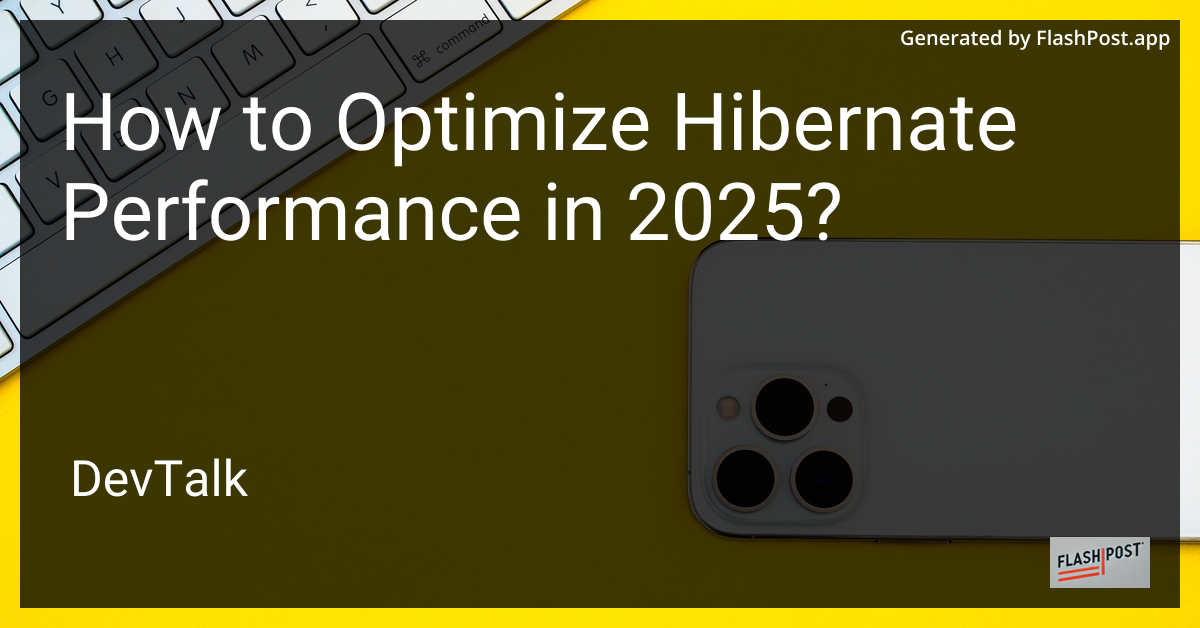How to Optimize Hibernate Performance in 2025?

How to Optimize Hibernate Performance in 2025
Hibernate remains a widely used ORM (Object-Relational Mapping) framework in 2025, capable of streamlining database interactions within Java applications.
However, optimizing its performance is crucial to ensure your application runs efficiently and meets modern demands. Below are some cutting-edge strategies and best practices that you can implement to optimize Hibernate performance effectively.
1. Leverage Batch Processing
Batch processing helps reduce the number of database calls and enhances application throughput. Use the hibernate.jdbc.batch_size configuration to set a suitable batch size that balances performance gains with transactional integrity. Typically, a size between 10 and 50 works well, but it's essential to test according to your use case.
hibernate.jdbc.batch_size=20
2. Use the Second-Level Cache
The second-level cache stores entity data across sessions, significantly reducing database access for repetitive data fetching. Utilize a caching provider like Ehcache or Infinispan by configuring it in your Hibernate settings.
<property name="hibernate.cache.region.factory_class">org.hibernate.cache.ehcache.EhCacheRegionFactory</property>
3. Optimize Fetch Strategies
Hibernate offers different fetching strategies—eager and lazy. By default, Hibernate applies eager fetching, which might result in fetching unnecessary data. Adjusting to lazy can significantly enhance performance, especially for associations you don't always need.
@OneToMany(fetch = FetchType.LAZY)
Learn More: Hibernate ORM Tutorial
4. Tune Connection Pool Size
A well-configured connection pool improves database access times. Tools like HikariCP provide excellent performance for connection pooling. Ensure your pool is neither too small to cause latency nor too large to cause resource exhaustion.
<property name="hibernate.hikari.maximumPoolSize">10</property>
5. Implement Proper Indexing
Indexing frequent query columns enhances retrieval times. Identify critical columns in your entity mappings and ensure they are indexed in your database schema to expedite query execution.
6. Utilize Stateless Sessions
For read-only operations, consider using Hibernate's StatelessSession. This session variant minimizes overhead by skipping some features like first-level caching, thus speeding up read-intensive scenarios.
7. Monitor and Profile
Monitoring tools like Java Melody or Hibernate's built-in statistics can reveal performance bottlenecks. Regularly profile your application to identify slow queries and optimize them as necessary.
8. Consider Custom Data Types
If you're dealing with non-standard data formats, implementing custom data types in Hibernate can help tailor the framework's operation to suit your use cases more closely. This can lead to more efficient data handling and reduced latency.
Explore Further: Hibernate Custom DataType
9. Optimize Object Associations
Efficiently managing object associations can have a significant impact on performance. Avoid cascading operations needlessly, and select the right fetching strategy based on the application's requirements.
Detailed Guide: Hibernate Object Association Update
Conclusion
Optimizing Hibernate performance in 2025 involves a combination of configuration tweaks, efficient data handling strategies, and constant monitoring. By leveraging these practices, you can ensure that your application remains responsive, scalable, and capable of handling modern workloads with ease. Stay proactive with regular updates and tweaking your setup based on profiling insights for continued efficiency gains.